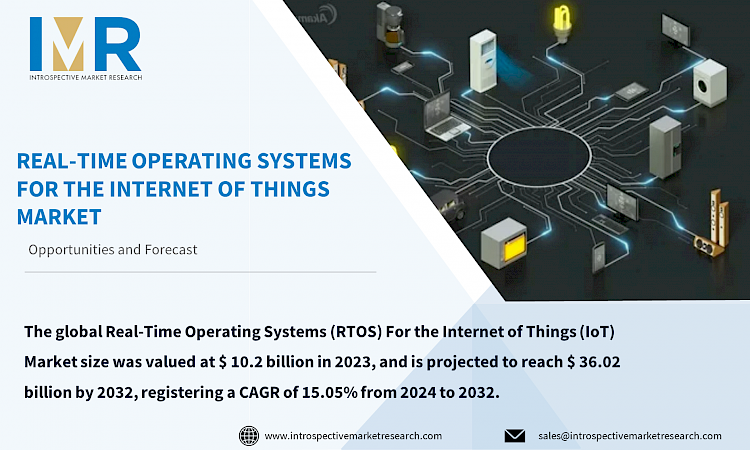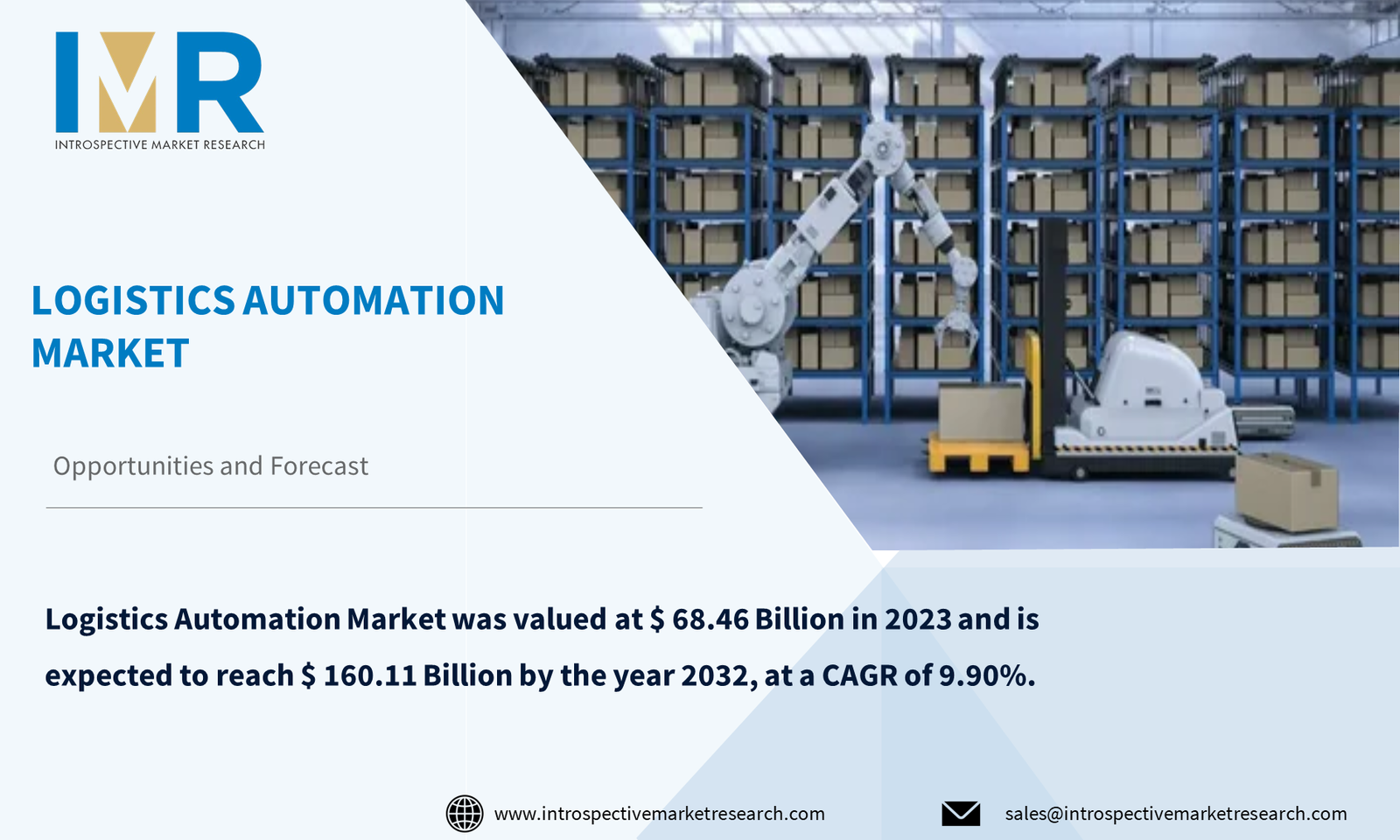
Real-Time Operating Systems (RTOS) For the Internet of Things (IoT) Market
According to a new report published by Introspective Market Research, titled, “Real Time Operating Systems (RTOS) For the Internet of Things (IoT) Market by Type, Application and Region: Global Opportunity Analysis and Industry Forecast, 2024–2032,”
the global Real-Time Operating Systems (RTOS) For the Internet of Things (IoT) Market size was valued at $ 10.2 billion in 2023, and is projected to reach $ 36.02 billion by 2032, registering a CAGR of 15.05% from 2024 to 2032.
Specific software systems called real-time operating systems (RTOS) are tailored for the Internet of Things (IoT) that control and perform tasks on IoT devices in a precise and responsive manner. They prioritize critical functions, ensuring high-speed computing, communication, and control in various IoT applications such as smart homes, industrial automation, and mobile devices. Real-time operating systems (RTOS) play an important role in the Internet of Things (IoT) by facilitating precise control and task performance of IoT devices in various fields such as smart homes, industrial automation, health monitoring, and wearables. RTOS provides real-time data processing, communication, and management, promoting seamless integration and interoperability in interconnected networks.
The Real-Time Operating Systems (RTOS) for the Internet of Things (IoT) Market is segmented into Type, Application, and region. By Type, the market is categorized into Hard Real-Time Operating Systems (RTOS), Soft Real-Time Operating Systems (RTOS), and Firm Real-Time Operating Systems (RTOS). By Application, the market is categorized into Smart Home, Industrial Automation, Wearables, and Healthcare. By region, it is analyzed across North America (U.S.; Canada; Mexico), Eastern Europe (Bulgaria; The Czech Republic; Hungary; Poland; Romania; Rest of Eastern Europe), Western Europe (Germany; UK; France; Netherlands; Italy; Russia; Spain; Rest of Western Europe), Asia-Pacific (China; India; Japan; Southeast Asia, etc.), South America (Brazil; Argentina, etc.), Middle East & Africa (Saudi Arabia; South Africa, etc.).
The increasing sophistication of IoT devices is acting as a major catalyst for the expansion of the Internet of Things (IoT) real-time operating system (RTOS) market. As IoT devices become more and more complex, there is a growing demand for operating systems that can manage tasks with precision and sensitivity. An RTOS, known for its ability to handle complex operations in real time, is well suited to these changing needs. In addition, the expanding functions of IoT devices, such as real-time computing, communication and control, emphasize the need for robust operating systems that ensure trouble-free operation under various conditions. RTOS excels at managing increasing complexity of IoT applications, enabling efficient allocation of resources and optimization of system performance.
Growing demand for edge computing is a significant opening for real-time operating system (RTOS) market expansion in the Internet of Things (IoT) space. Edge computing involves processing data closer to its origin, which reduces latency and saves bandwidth. Because RTOSs efficiently manage real-time tasks, they are ideal for extreme computing environments where timely processing is critical.
As edge computing gains momentum in various industries such as manufacturing, healthcare and transportation, the need for reliable and responsive operating systems becomes increasingly important. RTOS perfectly meets the strict real-time requirements of edge devices, which ensures fast decision making and smooth operation in distributed computing systems.
Global Real Time Operating Systems (RTOS) For the Internet of Things (IoT) Market, Segmentation
The Real Time Operating Systems (RTOS) For the Internet of Things (IoT) Market is segmented based on type, application, and region.
Type:
The type segment is further classified into Hard Real-Time Operating Systems (RTOS), Soft Real-Time Operating Systems (RTOS), Firm Real-Time Operating Systems (RTOS). Among these, the Soft Real-Time Operating Systems (RTOS) sub-segment accounted for the highest market share in 2023. The soft real-time operating system (RTOS) segment is emerging as the major growth driver for the Internet of Things (IoT) real-time operating system (RTOS) market. Soft RTOS prioritize the timely completion of tasks and allow occasional deadlines to be exceeded, making them suitable for applications with less stringent real-time constraints. This adaptability makes Soft RTOS very versatile for many IoT applications, including smart homes, consumer electronics, and multimedia devices.
Application:
The application segment is further classified into Smart Home, Industrial Automation, Wearables, Healthcare. Among these, the Industrial Automation sub-segment is anticipated to show the fastest growth by 2032. The industrial automation segment is expected to contribute significantly to the growth of the RTOS market in the Internet of Things (IoT) market. As industries increasingly integrate IoT technologies to improve work efficiency and productivity, the demand for RTOS in industrial automation is expected to increase. RTOS plays a key role in managing real-time operations in industrial environments by providing high-speed data processing, communication and control.
Region:
The Real Time Operating Systems (RTOS) For the Internet of Things (IoT) Market in Asia-Pacific is projected to show the fastest growth by 2032. Asia Pacific is poised to lead the growth of the Internet of Things (IoT) real-time operating system (RTOS) market. Rapid urbanization, technological advances and increasing investment in IoT infrastructure, especially in countries such as China, Japan and South Korea, will greatly increase IoT adoption across the region. This growth in IoT adoption increases the demand for RTOS to efficiently manage and perform tasks on IoT devices across various industries.
Some of The Leading/Active Market Players Are-
- Silicon Labs
- Synopsys, Inc
- Texas Instruments Incorporated
- BlackBerry Limited
- Infineon Technologies AG
- ARM
- NXP Semiconductors
- Nordic Semiconductor
- Renesas Electronics Corporation
- Huawei, and Other Active Players
Key Industry Developments
- In December 2023: The BlackBerry QNX Neutrino Real-time Operating System (RTOS), certified up to IEC 62304 Class C, is a tried-and-true real-time operating system that is safe and secure. Because of its strong microkernel architecture, medical device makers may concentrate on certifying just their software, which saves them a significant amount of development time.
- In May 2023, BlackBerry Limited announced the early access release of QNX® Software Development Platform (SDP) 8.0 to enable automakers and IoT systems developers to deliver more powerful products at lower costs while maintaining unparalleled safety, security, and reliability standards that QNX technology.
Key Findings of the Study
- The global Real Time Operating Systems (RTOS) for the Internet of Things (IoT) market size was $10.2 billion in 2023 and is projected to reach $36.02 billion by 2032.
- Applications of RTOS include Smart Home, Industrial Automation, Wearables, and Healthcare, with Industrial Automation expected to witness the fastest growth by 2032.
- Asia-Pacific is anticipated to lead the market's growth by 2032, driven by rapid urbanization, technological advancements, and increasing IoT adoption, especially in countries like China, Japan, and South Korea.






